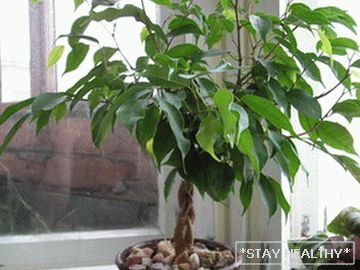 Wed, 02 Mar 2016
Wed, 02 Mar 2016
Род Фикус (Ficus) из семейства Тутовые
represented by evergreen and deciduous trees, shrubs and
woody lianas, which, according to various sources, are from
800 to 1000 species. Places of their growth are tropical and
subtropical areas located in Africa, Asia, America,
Australia, where in natural conditions these plants reach a huge
magnitude.
Leadership in prevalence among cultural ficus
belongs to Ficus rubber plant. Also noteworthy is a large
the popularity of ficus benjamin, ficus lyrate, ficus
Bengali and Ficus dwarf.
Contents
Ficus – growing and care
Ficus is very demanding on the temperature of the content and
does not take out sharp temperature differences. The most optimal
the temperature for it is from 25 ° C in spring and summer
period, and from 16 ° C – in winter.
The location of the ficus should be as bright as
with a lack of lighting, their branches begin to reach for the light, they have
the internodes are lengthened and the number of leaves decreases. Perfect
the place for the ficus pot is the space near the western and
east windows. In winter, it can also be located on the south side, and
Here in the summer in this direction the ficus will have to be attented to
the plant did not suffer from the direct midday sun. But,
it is impossible to move the ficus too often so that abrupt changes
provisions did not cause the leaves to fall. Also need it
protect from drafts.
Ficus needs to ensure uniform watering throughout the year,
which by the summer should be abundant. For watering should
use warm soft water separated for at least 12
hours In the case of tree species, it is important to let the soil dry out.
between watering, ampel forms should be watered more often. If a
the plant will not get enough moisture, then its leaves will begin
to turn yellow and fall off, which, for example, for small-leaved species may
cause death. But, чрезмерный полив также может
lead to leaf fall and root collar decay.
In summer, the ficus should be fed every 15 days by any
organic fertilizer for indoor plants. Winter feeding
should be carried out no more than 1 time in 2 months. In the period of active
growth should use high nitrogen fertilizers,
they stimulate the growth of leaves, in winter, on the contrary, an excess of nitrogen
it is undesirable that the ficus does not start to grow with insufficient
lighting. In the first two months after transplantation it is also not necessary.
feed as new soil contains all the necessary
plant nutrients.
The ficus is very good at spraying, but you need to
use only warm, preferably boiled water to avoid
formations on the leaves of white lime scale. Spraying
You can not even hold once a day. Should be from time to time
wipe the leaves with a damp sponge.
Фикус – пересадка и breeding
Ficus transplantation carried out in the spring. For young plants this
the procedure should be carried out annually, after reaching 5 years
repotted every 2 years, for old tub plants the interval
between transplants is about 3-4 years. For cooking
soil mixture for transplanting take equal parts compost or
humus, sod, peat ground and sand (replanting large
woody specimens, the proportion of sod land should be increased).
For reproduction of ficuses use semi-woody apexes.
cuttings with leaves. To do this, pre-flush with cuttings
milky sap, it should be put in water and placed on a sunny
window before the roots, or rooted in the sand or water at
temperature from 25 to 30 degrees.
Ficus – diseases and pests
If a у фикуса начинают желтеть и опадать листья, значит, ему не
enough nutrients and it should be transplanted into more
nutritious soil.
Premature fall of the leaves, the appearance of yellow on them
specks or yellowing of the edges of the leaves suggests that the plant
suffers from excess moisture. So the soil should be given the opportunity
dry out between watering.
If a содержать фикус в помещении с излишне сухим воздухом, или
Do not shade it from direct sunlight, or not provide it
sufficient watering, its leaves can wrinkle. In this case
it is necessary to provide the plant with optimal watering and regular
spraying.
Sudden abscission of leaves can talk about waterlogging
(if we are talking about rubber plant and lyre), lack of
light or abrupt climate change (from Ficus Benjamin). Besides,
the reason for this may be the use of cold water for irrigation,
low room temperature, lack of light, excess
nutrients in the soil or staying in a draft.
Elimination of these causes, as a rule, leads to normalization
plant condition.
Untimely transplant or transplant to poor soil,
lack of dressings or violation of temperature and light
regimes can lead to the fall of the leaves up to the full
exposed the trunk.
Room temperature too high, dry air or
excess fertilizer can cause brown spots
on the tips and edges of the leaves.
Also ficuses can be affected by pests: thrips and shields.
To get rid of them, you need to wipe the leaves with sponge sponge,
moistened in soapy water, and then treat the plant with any
systemic insecticide.
By following these simple rules, you can grow beautiful things at home.
a plant that is famous for its good energy and brings in
the house is not only beauty, but also home comfort and peace.





